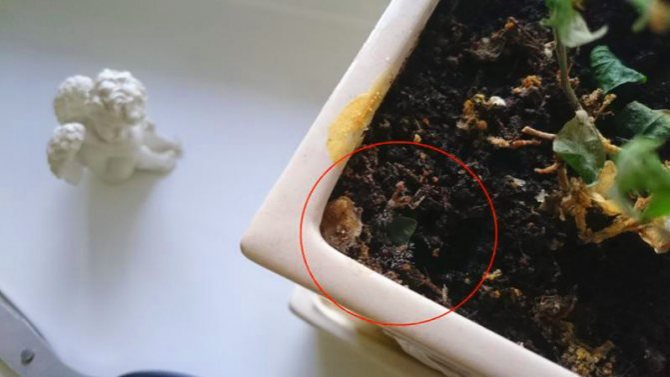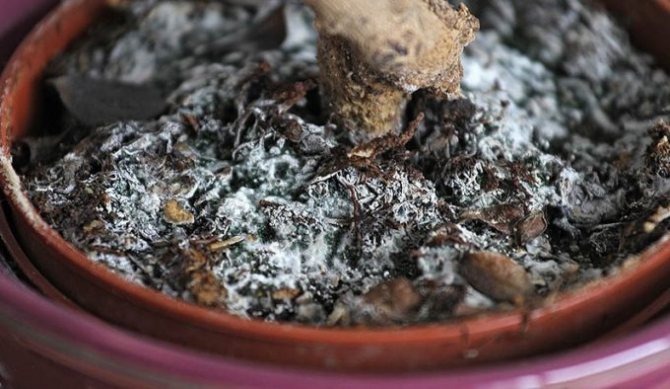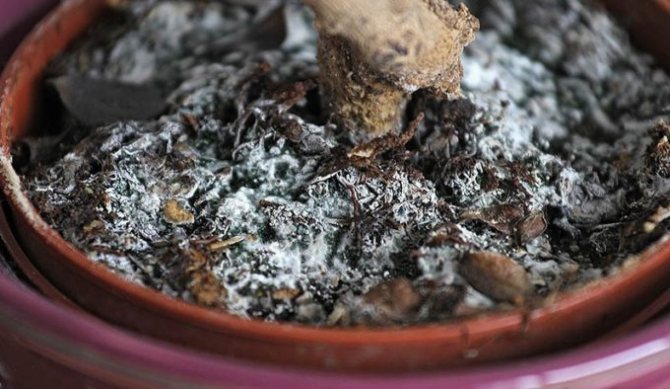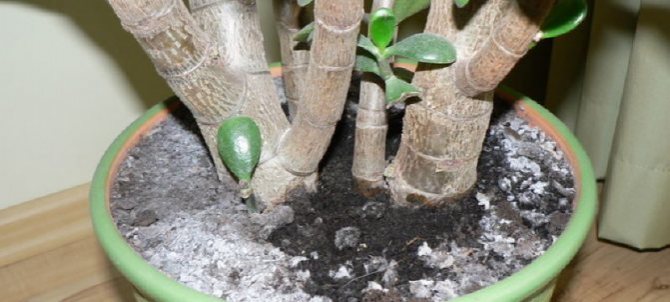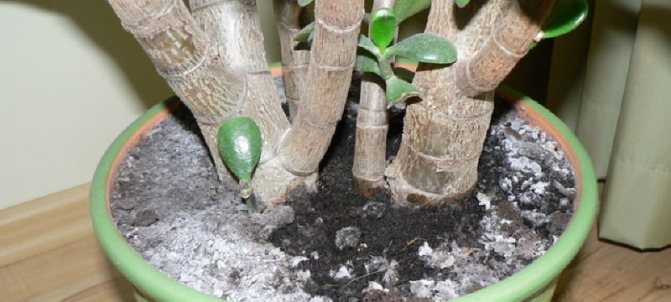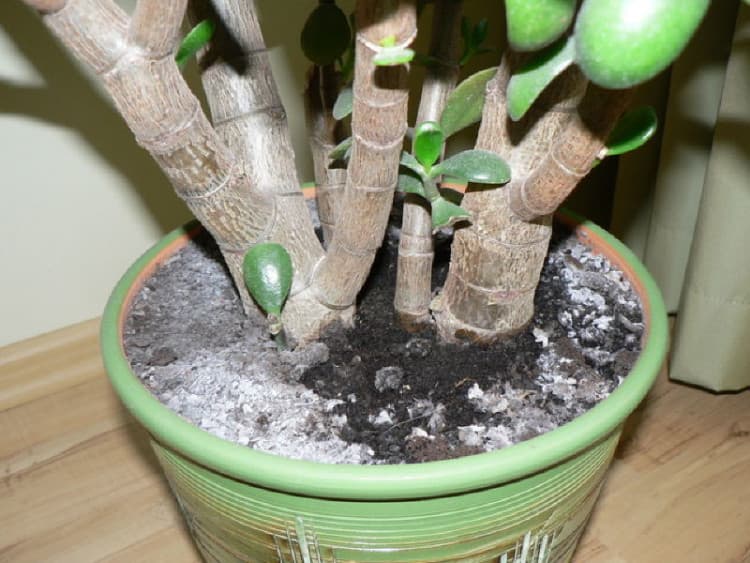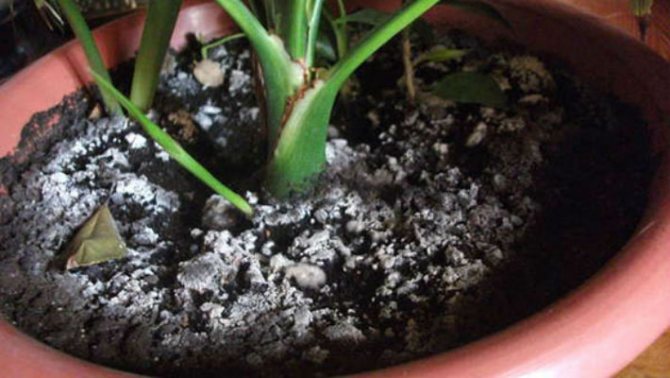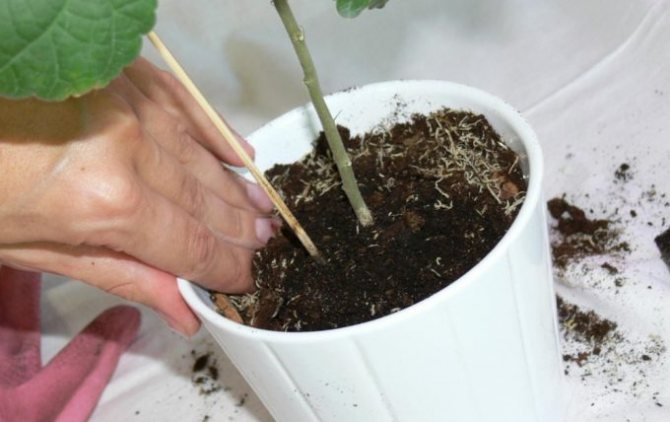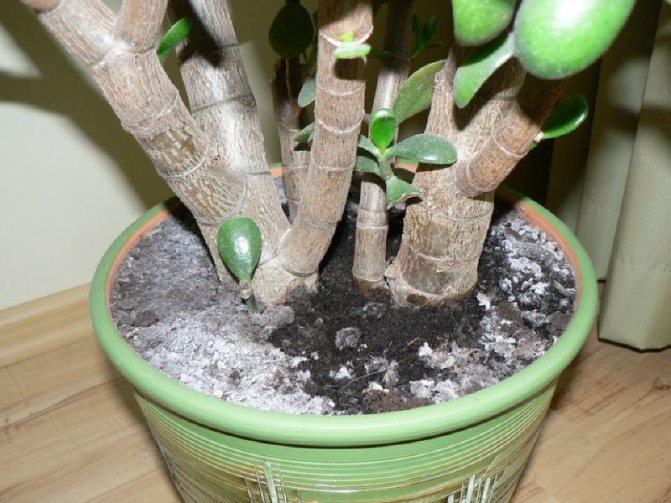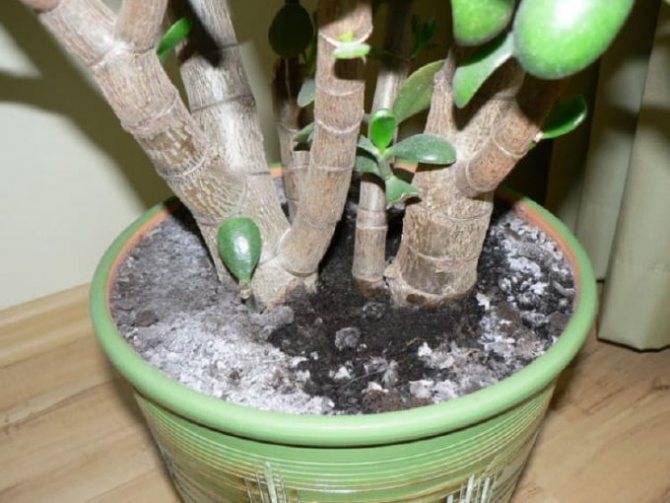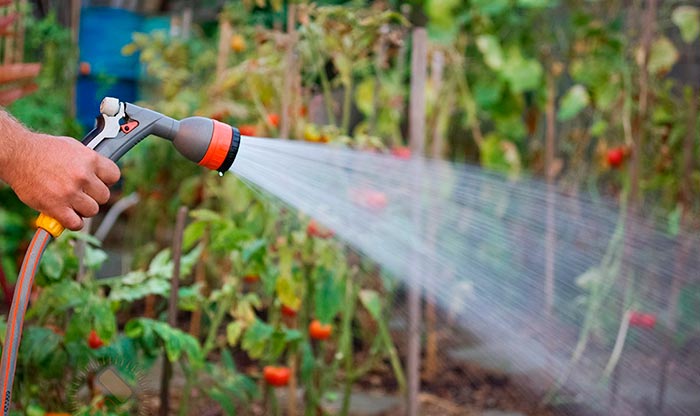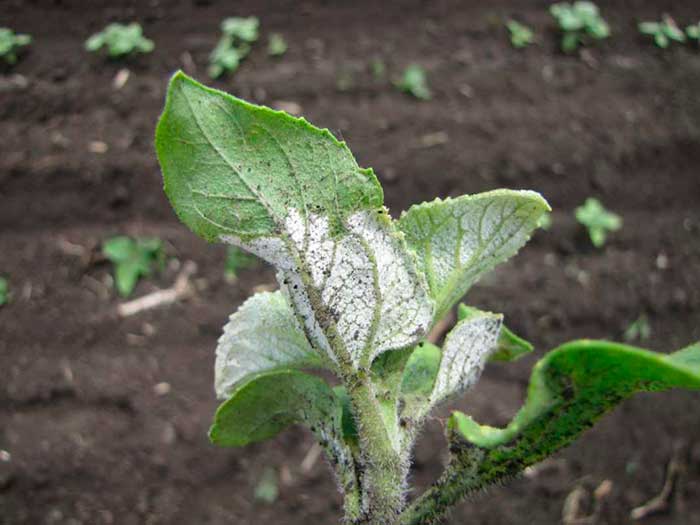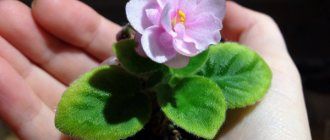What is important when growing indoor plants? Of course, a good soil, because it is he who gives our flowers the nutrients, thanks to which they actively grow and delight with their flowering. Poor-quality soil not only inhibits growth, but can also cause the death of indoor crops, so all growers carefully choose a suitable substrate for their pets. However, it often happens that a good, nutritious soil mixture is covered with a white blanket.
There may be several reasons why the ground in flower pots is covered with a white coating, namely:
- poor-quality water is used for irrigation;
- a fungal infection has settled in the flowerpot.
Plaque on dry ground in flowers
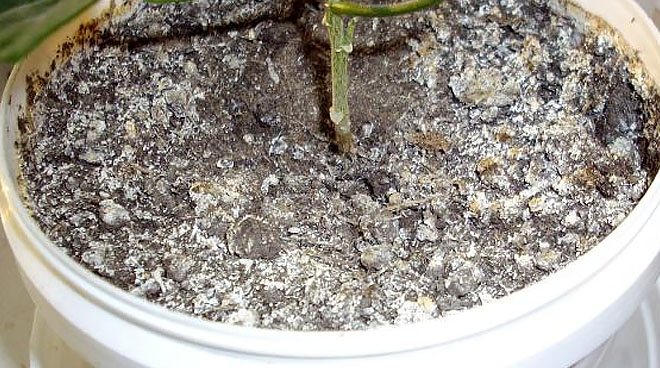
When this plaque appears, the flowers will develop poorly and, if nothing is done, they will eventually die. A white dry layer forms on dry soil due to various factors, one of which is hard water.
Hard water
If you water your indoor flowers with tap liquid, then most likely you will have a problem with white bloom. This is due to the fact that tap water is hard, and there are several ways to soften it:
- Boiling
- Freezing
- Special means
If you do not want to bother with softening the water, rain or melt water (snow) is suitable for watering potted flowers. Collect the rainwater in a clean container and use it to water your plantings.
How to soften water for irrigation
As mentioned earlier, you can use one of three methods to soften the water.
Boiling


To do this, you need to boil the water and let it settle for a day. Pour water into a container for irrigation, and remove the sediment. Plants can be watered with this liquid, but some experts do not recommend doing this. after boiling, the water loses oxygen and this will not benefit the plants. But such a liquid cannot bring much harm either, so you can use this method if there is no other way out.
Freezing
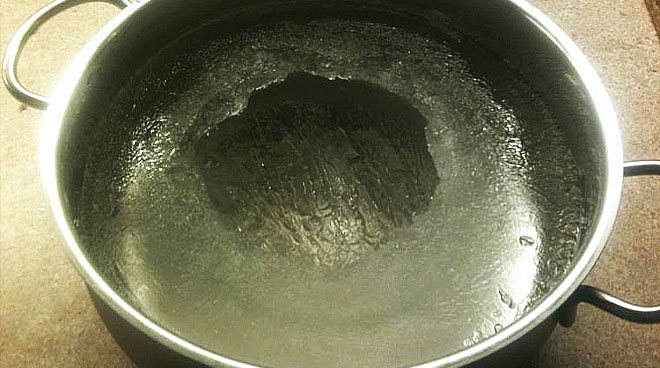

The white layer is the remnants of the salt that is present in the water, they also make the water hard. To remove them, you can freeze the water. Because salt crystals and water crystals have different freezing temperatures, then when we freeze hard water, water first freezes, and only after it is salt. Therefore, as soon as the water has turned into ice, we take it out, and drain the rest of the water in which the salt remains. We defrost the ice and water our potted flowers with it.
Special means
To do this, go to a garden store and buy a water softener. Use this product to soften the water. After using the product, it is better to let the water settle. For better water softening, follow the instructions on the package. If there are no instructions on the package, you need to buy a good product with instructions.
Other causes of whiteness on earth
The heavy texture of the soil in the pot contributes to the appearance of a white layer. In this case, there is a high capillarity of the soil. The water comes out to the surface of the soil and evaporates, leaving behind salt residues. The same thing happens when the flower pot is too large. You water the soil a lot to moisten the entire perimeter of the pot, but the vegetation cannot absorb that much water, and it eventually evaporates on the soil surface and leaves a light layer. The rapid evaporation of water on the soil surface is affected by dry air in an unventilated room.
If all of these factors do not apply to you, then you are using a lot of feeding in the form of nutrient solutions.
How to get rid of mold
Purchased funds
To combat fungal infection, commercial drugs are used.
- Sarfun 500 sc. It is produced in the form of a concentrated suspension. Manufactured in Poland. Recommended in our country. It is a broad-spectrum fungicide. They can be sprayed with plants. It is especially good to do this during the growing season. It has a healing effect. Can be used for preventive purposes. Safe for shoots and the environment. Has a long lasting protective effect up to four weeks. Does not wash off when spraying a flower. Easy to use. Acts on the parasite, causes a disturbance in the metabolism of fungi a few hours after treatment. The procedure is best done in the morning and evening. When processing, you should try to prevent the drug from getting on the mucous surface and protect your eyes.
- Topsin M. Systemic contact drug, which belongs to fungicides. It is used as a prophylaxis and for medicinal purposes. He copes with fungal infection and parasites: aphids, leaf beetles, lacewing. It is produced in the form of a powder that dissolves well in liquid. It can also be in the form of an emulsion. The active substance is topsin. In the preparation, its content reaches 70 percent in the powder, and 50 percent in the emulsion. It inhibits the growth of fungal spores. Penetrates the roots. It has a beneficial effect on diseased shoots. Completely infects parasites and blocks their development. After processing, the plant begins to grow well, stretches. The remedy takes effect within the first day. Processing is carried out during the growing season. The plant is re-treated in two weeks. There are analogues of the above drugs: fungicit Azofos, Tiovit Jet.
- Azophos. Highly effective product. Actively fights fungal infection. It not only infects fungi, but also provides nutrition for the weakened plant. Nourishes and promotes growth. It contains important trace elements: nitrogen, phosphorus, etc. It resembles the effect of Bordeaux liquid. Destroys fungal spores.
Note! Topsin M can be habit-forming.
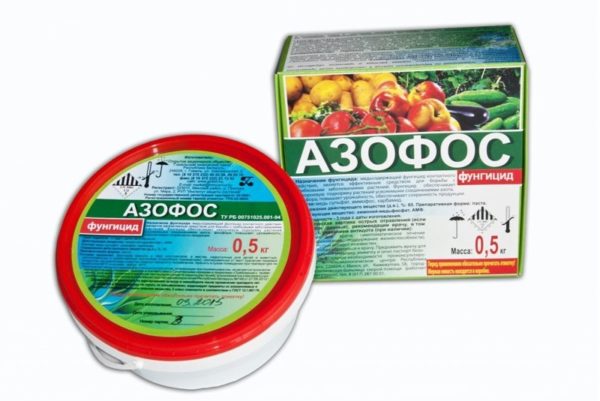

What to do?
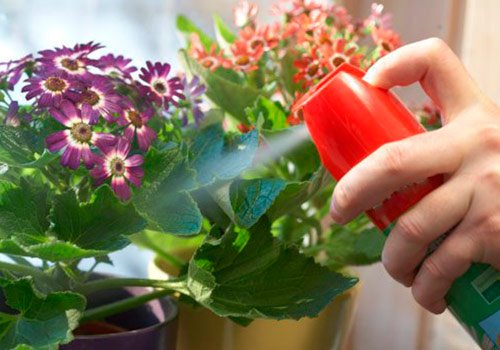

There are different ways to deal with this plaque. I find it easiest to remove the top layer and replace it with fresh soil. I add some river sand on top and mix it with the top ball of soil. I had to get rid of mold only by completely replanting the plant and pretreating the pot with laundry soap and boiling water.
Well, for how to prevent many other problems with indoor flowers, see this video:
Marina Makarova
Why mold is dangerous for indoor plants
Gray, black, white mold on the ground in flower pots is not just an external defect in the soil. A fungus that has settled in the soil causes irreparable harm to the plant itself.
- The ground becomes covered with a dense crust, acquires a moldy smell. Normal air exchange is disturbed in the soil.
- Soil quality decreases: changes in soil acidity and mineral composition.
- Plant roots weaken and rot due to excessive moisture.
- Stems, leaves do not receive enough nutrients and begin to wither gradually.
- The plant dries up, turns yellow, begins to emit a rotten smell, and eventually dies.
We advise you to read: Allergy to mold in children and adults: how is it manifested and how is it treated?
Signs about a flower pot in a dream
When you dream of flowers in pots, this is one of the most favorable stories that predicts good luck and success in the future. Perhaps a large material reward awaits a person in front, or he will buy expensive property. However, this interpretation is true in the case when the flower did not fall and dreamed of blooming, green and fresh. If in a dream a person sees sluggish, dried flowers, then this may indicate trouble in the future. For example, there will be troubles at work, financial losses or family quarrels. When a flower crumbles in a dream, it speaks of illness.
If in a dream a person dropped and broke an empty pot on the floor in the room, poured earth from the pot or broke it, then this may portend a family discord in the future, up to a divorce. Also, scattered earth at night speaks of illness, loss of loved ones or financial difficulties. It is worth considering that dream prediction may depend on who dreamed of the flower pot. For example, if a young girl dreamed of a beautiful flower, then a wedding awaits her. For older women, a blooming flower speaks of a possible pregnancy, and for older women, such a dream promises the presence of diseases of the reproductive system.
What to do if a white bloom appears on the leaves of the plant?
Powdery mildew (ash, linen) - a rapidly spreading fungal disease.
The first "symptom" is a white bloom on the leaves, which at first glance may seem like ordinary dust. When the leaves are covered with it, the plant loses nutrients, and the process of photosynthesis stops.


At first, white bloom appears only on the lower leaves of violets and other plants, but over time the disease progresses, moving to the rest of the plant. The leaves turn yellow, wither, and the new leaves have an unhealthy appearance, grow twisted.
If you do not take up the treatment of the plant in time, it will soon die.
I recommend reading - Orchid has white mold.
What are the reasons for the disease?
Fungal spores are always found in the soil, but with proper plant care, they are not “activated”. The fungus begins to manifest its evil essence if:
It's damp, cold outside
For example, it rains every day. In this case, white bloom on the leaves of ficus and other plants often appears when they are grown on the street or balcony.
If you still need a transplant of indoor plants
If the above measures did not help, it is possible that the plant will need a transplant.
Dig the flower out of the ground carefully. Treat the roots weak solution potassium permanganate.
The moldy soil should be thrown away and the pot disinfected. If it is ceramic, you can hold it in the oven, or pour boiling water over it. Please note that plastic pots are difficult to decontaminate, and there is a good chance that fungal spores will not be completely removed from them.
Pour a few centimeters of drainage at the bottom of the pot - you can buy it at specialty stores such as Priroda. The drainage should be followed by soil, also purchased from the store (give preference to "light" soils, with a lot of peat).
Then plant the plant.
And remember that from now on you will water it much less often than before.
Fungus
Fungus may develop in flower pots. It differs in structure - it is easily rubbed in the palms, in contrast to salt stains, which do not lose their shape.
It is recommended to first adjust the care of the plant by reducing the frequency of watering and the volume of liquid. So that the problem does not recur in the future, be sure to loosen the soil, just do it carefully so as not to accidentally damage the root system.
Use the right fertilizer, as the wrong choice can cause flower death. Follow the instructions when feeding, remembering that overdose is much more dangerous than underfeeding.
How to properly get rid of fungal plaque
To get rid of white bloom and at the same time not harm the plant, you must first remove the top layer of soil.
Then the flower is watered with water with the addition of citric acid to prevent the fungus from multiplying further.
The removed soil is replaced with a new layer of soil with the addition of bactericidal agents - for example, wood pieces of coal or sphagnum.
Then pour the fallen flowers with a solution with a foundation. In 1 liter of water, you need to dilute 2 grams of the product.To prevent the situation from repeating in the future, watering with water with citric acid for prevention should be carried out at least twice a month.
You can also quickly get rid of mold with the help of store-bought products. When choosing them, be sure to take into account the type of soil, the characteristics of the plant, as well as the degree of damage by the fungus, so as not to get the opposite effect, finally ruining an already weakened flower. Give preference to organic preparations that affect the soil, making it unfavorable for the spread of the fungus.


